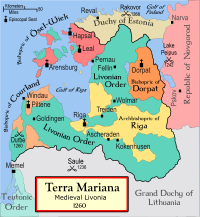This article needs additional citations for verification. (April 2011) |
You can help expand this article with text translated from the corresponding article in Estonian. (August 2023) Click [show] for important translation instructions.
|
| Saint George's Night Uprising | |||||||
|---|---|---|---|---|---|---|---|
 Medieval Livonia | |||||||
| |||||||
| Belligerents | |||||||
| Revala, Harria, Rotalia, Vironia, Oeselia | Bishopric of Ösel–Wiek | ||||||
| Commanders and leaders | |||||||
| Vesse of Oeselia † |
| ||||||
Saint George's Night Uprising in 1343–1345 (Estonian: Jüriöö ülestõus, Estonian pronunciation: [jyri.øː yles.tɤus]) was an unsuccessful attempt by the indigenous Estonian population in the Duchy of Estonia, the Bishopric of Ösel-Wiek, and the insular territories of the State of the Teutonic Order to rid themselves of Danish and German rulers and landlords who had conquered the country in the 13th century during the Livonian Crusade; and to eradicate the non-indigenous Christian religion. After initial success the revolt was ended by the invasion of the Teutonic Order. In 1346, the Duchy of Estonia was sold for 19,000 Köln marks by the King of Denmark to the Teutonic Order. The shift of sovereignty from Denmark to the State of the Teutonic Order took place on November 1, 1346.